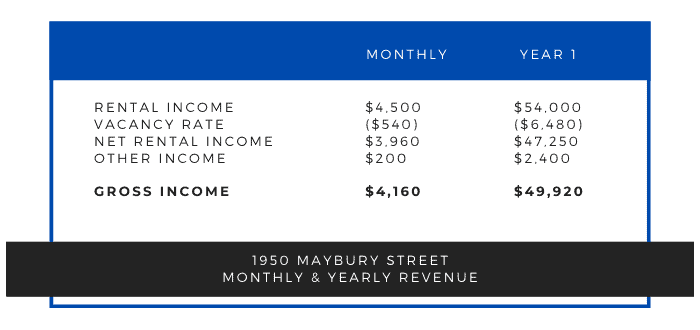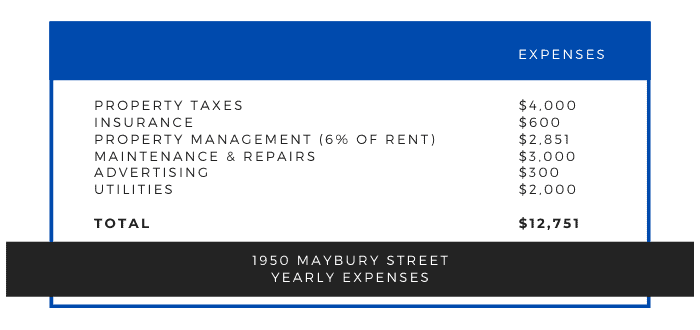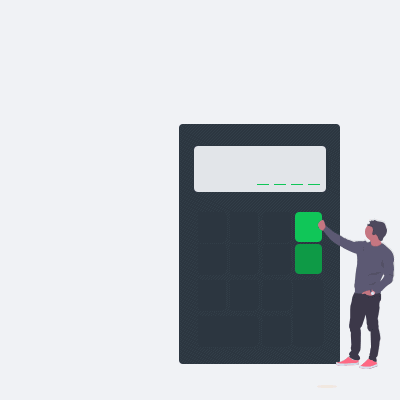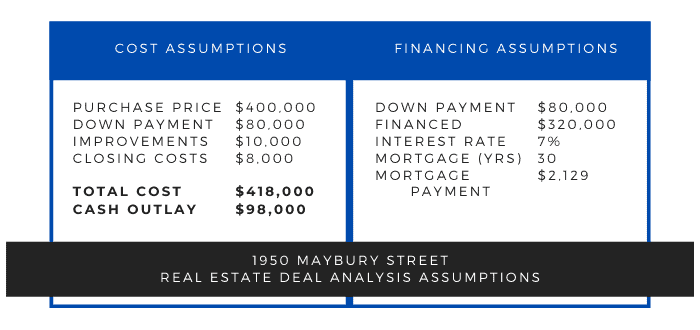Are you planning on buying a rental property for the first time? If so, you’ve come to the right place!
Investing in a rental property is a smart choice because rentals are an excellent hedge against inflation and they continue to earn steady ROI during tough economic times.
In this article we will share with you an introduction to rental property investment analysis.
Different-sized properties require more or less analysis, but consider this guide your 101-level primer to analyzing any multi-unit residential property—from two-unit duplexes to 500-unit complexes. This analysis even works for single-family rentals, but keep in mind that the market value for single-family homes is determined differently than for multifamily properties.
Determining the value of your real estate investment
Like I said, different properties are valued differently. Assessing a triplex the same way one might evaluate a single-family home leads to a wildly skewed value. Here’s what you need to know.
Single-family homes
Market “comps” determine the value of single-family homes, investment or not. These comps—or “comparables”—are nearby properties with similar characteristics. They share variables like floorplan, number of bedrooms and bathrooms, garage size, and amenities. A single-family investment home generally rises in value if a similar home is also rising in value—and vice versa.
Multi-unit properties
Larger investment properties—those with at least two units, and especially those with more than four—are priced and valued differently. The value equates directly to how much income or profit the property produces. It’s possible that an apartment building in a neighborhood where house prices are dropping could, in fact, increase in value.
You can’t just compare your apartment building to others down the street to see how much it’s worth. That’s why real estate investment analysis is so important.
There are several primary factors to consider, but cash flow and appreciation are the two most important variables. Cash flow is simply the money left after all the bills have been paid, and appreciation is the equity gained as the property value increases.
There are not a lot of great ways to estimate future appreciation without a crystal ball, so I generally choose to focus on the cash flow.
Gathering your information
Good financial analysis involves inputting a bunch of information into a financial model and using its calculations to determine whether the investment is good or bad—and right for you. Know these variables for the most thorough financial analysis of a residential rental property:
- Property details: Number of units, square footage, utility metering design, etc.
- Purchase information: Total purchase expenses—or purchase price plus rehab or improvement costs
- Financing details: Mortgage or loan information, such as the total loan amount, down payment, interest rate, and closing costs
- Income: Rent payments and any other income the property produces
- Expenses: Maintenance costs, including property taxes, insurance, and maintenance
Pro-forma vs. actual data
Getting good data from your model requires reliable, accurate information. Remember: It’s in the seller’s best interest to provide appealing—not accurate—numbers. For example, they may provide high rental income estimates or neglect to mention certain maintenance expenses. Part of the investor’s job is ensuring you have the best available information.
“Pro-forma”—or estimated—data from the seller merely kick off the discussion. Before closing, determine the actual numbers. Ask to see previous years’ tax returns, property tax bills, and maintenance records. Hopefully, the actual data is similar to the pro-forma data—but don’t be surprised if it’s different.
Check for potential surprise, too. For example, when was the last time the property was assessed for taxes? If it was a while ago, and values have increased significantly, it’s possible that the property will soon be reassessed and taxes will increase. Even small changes to the income and expense numbers can mean big changes in your bottom line.
Where to find data
Not sure where to track down the necessary information? Start here.
- Property details should be available from the seller. Check with your local records office for more comprehensive, detailed information.
- Purchase information includes any upfront maintenance or improvement work that must be completed before the property can meet its income potential. Have the property inspected to ensure that there are no hidden issues or problems.
- Financing details can be provided by your lender or mortgage broker.
- Income details come directly from the seller—but don’t rely on pro-forma data. You can also talk to the property management company currently handling the property, if one exists, for this information
- Expenses should also come directly from the seller or property management company. A building inspector can warn you about any major repairs that may come due, such as a new roof or HVAC system.
Elements of real estate investment analysis
The best way to teach real estate investment analysis is with numbers. Let’s take a sample property—1950 Maybury Avenue. Here are the stats you’ll need to know:
| Units | Eight, with seven rented and one vacant, and needing $10,000 in repairs |
| Price | $400,000 |
| Cap rate | 9% |
| Gross income | $54,000 |
| Other income | $2,400 from laundry |
| Vacancy rate | 12% |
| Taxes | $4,000 |
| Insurance | $600 |
| Maintenance | $3,000 |
| Advertising | $300 |
| Utilities | $2,000 |
| Net operating income | $37,169 |
Calculating net operating income
One of the cornerstone metrics of your financial analysis is “net operating income” (NOI). This determines the total income the property generates after all expenses, not including debt service costs—or your loan costs.
In mathematical terms, NOI equals the total income of the property minus the total expenses of the property:
NOI = Income – expenses
Typically, NOI is calculated monthly using income and expense data, which can be easily converted to annual data simply by multiplying by 12.
Assessing property income
Gross income is the total income generated from the property, including tenant rent and other income from things like laundry facilities and parking fees. 1950 Maybury, for example, has eight units renting for between $525 and $650 per month, for a total of $4,500 per month. In addition, we have $2,400 per year in additional laundry facility income. That means total monthly income is $4,700, and annual income is $54,000.
Most of a property’s income generally derives from tenant rent—making it extra important to account for unit vacancy. Most areas have an average vacancy rate, although your property’s specific vacancy rate may be higher or lower. If so, you’ll want to factor that into your analysis.
Here are questions to ask if the vacancy rate doesn’t correlate with the average local vacancy:
- Is the data pro-forma or actual? If it’s actual, what is the current management doing to keep the building filled?
- Is the rent lower than market rents?
- When do current leases expire?
You’ll need to determine what you think is a reasonable vacancy rate going forward—I recommend erring on the conservative side.
When determining how much income you can expect, start by subtracting the income that you likely won’t see due to vacancy. In our example property, only one out of eight units is vacant, equating to about 12 percent vacancy. We’ll use that number for our analysis.
So, our total monthly income would be $4,160, with a total annual income of $49,920.

Assessing expenses
Now let’s calculate our total expenses for this property. In general, expenses break down into the following items:
- Property taxes
- Insurance
- Maintenance—estimated based on the age and condition of property
- Management, if you employ a professional property manager
- Advertising
- Landscaping, if you hire a professional landscaping company
- Utilities, assuming any portion of the utilities is paid by the owner
Convert any monthly expenses to their annual costs to find the property’s annual operating cost.
Common expenses
Every property owner will encounter these common expenses—so it’s important to learn how to estimate the cost.
- Repairs: Repairs are difficult to estimate because there are a lot of variables that come into play. When estimating potential repair cost, look at the property itself. Generally, you can assume between 5-15% of the rent, depending on the condition and age of the property. And keep in mind that you may go six months without a single repair and then get hit with a $1,500 water leak. You just never know.
- Capital expenditures: Also known as “CapEx,” this means those expensive big-ticket items that need to be replaced every so often, such as roofs, appliances, and HVAC systems. For each major system, estimate the cost to repair, divided by the remaining lifespan, and set aside that amount every month.
- Property management: Property management companies typically charge a percentage of the rent, along with a fee to rent out a unit. These numbers can change based on your local area, but in my area, property managers charge 10% of the rent and 50% of the first month’s rent when a unit is turned over.

Calculating NOI
Now that we have our total annual income and expenses, we can calculate NOI using the previously mentioned formula:
$49,920 – $12,751 = $37,169 NOI per year
NOI doesn’t give you the whole picture—or even enough information to make any decisions, though. Instead, it is the basis for calculating most of the important metrics in our analysis.

Start analyzing today
A good investment begins with a solid plan built upon solid math. Quickly and efficiently analyze a potential real estate investment using BiggerPockets’ investment calculators. We’re here to help you maximize your profit while lowering your risk—no matter your strategy.
Common real estate performance measurements
In the last section, we learned that NOI was the total income the property produced. But you might have been wondering, “Why doesn’t NOI include the expense cost of the loan, since that will ultimately affect your bottom line?”
Now, it’s time to get serious about cash flow.
Cash flow
Cash flow is the money left over after all the rental property bills have been paid. However, this simple definition gets a lot of people in trouble. You see, technically, cash flow is:
Income – expenses = cash flow
But income may include more than just the rent, and expenses will include more than just the mortgage. You might say, “The mortgage is $800 per month and the property will rent for $1,000 per month—so my cash flow is $200 per month.”
False.
Other expenses include:
- Taxes
- Insurance
- Flood insurance (if needed)
- Vacancy
- Repairs
- Capital expenditures
- Water
- Sewer
- Garbage
- Gas
- Electricity
- HOA fees (if needed)
- Snow removal
- Lawn care
- Property management
Some of these items are easy to calculate. You can call your insurance agent and ask for a quote, or ask the HOA president about typical fees. Don’t get overwhelmed—the more properties you look at, the more you will understand what’s “normal.”
Unlike NOI, cash flow also includes your debt service under “expense.” We don’t include debt service in the NOI calculation because NOI dictates how much income the property produces—independent of the owner’s financing.
The monthly or annual debt service amount is specific to your financing plan. If we included debt service in the NOI, then NOI would only be meaningful for that specific loan. Different buyers have different financing, so it’s important to have a property-specific income metric.
As might now be obvious, cash flow is your total annual rental property profit. The higher your loan payments, the smaller your cash flow. If you pay cash for a property, your cash flow is the NOI exactly, because that’s the property’s maximum cash flow.
Our monthly debt service on Maybury is $2,129, making our annual debt service $25,548. For this property, our cash flow would be:
$37,169 – $25,548 = $11,621
Paying cash minimizes debt service and thus maximizes cash flow. So, if you have the means to pay all cash for the property, why wouldn’t you? There are good reasons.
Rate of return
Cash flow isn’t the only important factor. You must consider the rate of return—also known as return on investment or ROI—too.
ROI is your cash flow relative to the cost of your investment, or your “basis.” Mathematically, that would be:
ROI = Cash flow / investment basis
What is a reasonable ROI? Let’s compare other investing vehicles.
- High-interest savings accounts often have an ROI, or interest rate, of between 2-5%.
- A certificate of deposit (CD) sports an ROI of about 5%.
- The stock market has an average ROI of about 8-10%.
So, what’s our ROI on Maybury? There are a few numbers you should consider in your real estate investment analysis.
Capitalization rate (or cap rate)
Just like NOI is completely independent of financing costs, cap rate is a neutral figure independent of the buyer or their financing. It’s calculated as follows:
Cap rate = NOI / property price
Cap rate may be the single most important number in your real estate investment analysis. The cap rate is independent of the buyer and financing, making this calculation the most pure indicator of a property’s potential return.
Here is the cap rate for Maybury:
$37,169 / $418,000 = 8.89%
Here’s another way to think about cap rate: It’s the ROI you would receive if you paid all cash. Cap rate assumes the maximum investment amount—the full price of the property.
A “good” cap rate depends on where you’re buying. Most areas, however, see maximum cap rates between 8-12%.
Just like single-family houses, where prices are determined by comparable rental property houses nearby, larger investment properties are valued based on the cap rate of comparable investment properties. If the average cap rate in your area is 10%, look for a 10% cap rate investment, at minimum. (Barring other more complex situations and considerations.)
Cash-on-cash return (COC)
Just like there are multiple income measures—NOI and cash flow—there are also multiple measures of return. The cap rate is the rate of return independent of rental property financing, and the cash-on-cash (COC) return is dependent on financing. It’s directly related to the amount of cash you put down.
If you put $100 into a savings account, you might receive $4 per year, or 4% ROI. The COC measures your return if you had instead put that $100 into the property. COC is calculated as follows:
COC = Cash flow / investment basis
For Maybury, the annual cash flow is $11,621. In total, the down payment, improvements, and closing costs equal $98,000, creating a COC of 11.86%.
Here, we see clearly that Maybury beats both savings accounts and diversified stock portfolios… albeit with a lot more time and energy spent.
Everyone’s ideal rate of return varies. However, if you’re getting less than a 10% return on a property, it’s probably not worth your investment—consider investing that cash in the stock market instead.
Total ROI
In addition to cash flow, there are several other key financial considerations in your real estate investment analysis:
- Tax consequences: You may gain or lose money to taxes.
- Property appreciation: Because the real estate market is volatile, you may not be able to predict this.
- Equity accrued: And don’t forget, your tenants’ rent pays off the property.
COC only considers cash flow’s financial impact; total ROI considers all the factors affecting your bottom line. It’s calculated as follows, where “total return” contains all of the considerations above.
Total ROI = Total return / investment basis
Let’s assume we can expect a 2% yearly appreciation for Maybury—or $8,360. The equity accrued in the first year of the mortgage is $3,251. And for the sake of this example, no tax breaks are available—or taxes due.
The total return for Maybury would be $23,232, making the total ROI 23.71%.
Not too shabby, huh?
Contact Rent Portland Homes
Once you buy your first rental property, don’t manage it yourself.
Earn passive income from that rental property when you hire a property manager.
Our team specializes in managing rentals in Portland, Beaverton and the surrounding area.
For a property management quote, click here.





